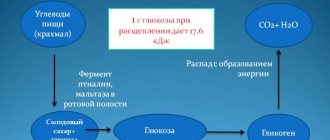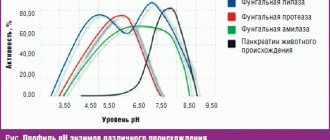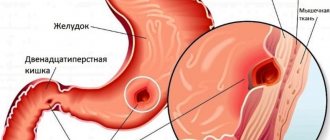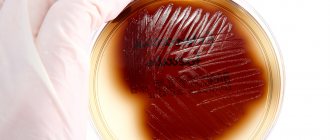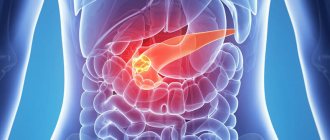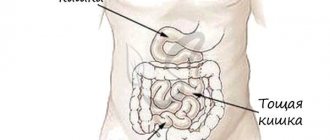Digestive enzymes - what are they?
The popular expression “you are what you eat” really does carry a certain amount of wisdom. But it would be more accurate to say “you are what you digest.” And this is where digestive enzymes, or enzymes, help us, the key to good digestion, a healthy gut and getting all the nutrients you need.
Oddly enough, until relatively recently, little was known about the mechanism of the digestive system. Today, the number of diseases associated with malabsorption of nutrients due to a lack of digestive enzymes is increasing.
Why are these enzymes so important? The role of digestive enzymes is primarily to act as catalysts to speed up specific, vital chemical reactions in the body.
They help break down large molecules into particles that are easier to digest. These particles are used by the body to maintain optimal performance and health.
Types
All major digestive enzymes can be divided into three classes:
- proteolytic enzymes necessary for protein metabolism.
- lipases, which are necessary for the digestion of fats.
- amylase, necessary for the breakdown of carbohydrates.
There are several types of enzymes found in the human body, including:
- Amylase. It is found in saliva and pancreatic juice and converts large starch molecules into maltose. Amylase is necessary for the metabolism of carbohydrates, starch and sugars, which predominate mainly in plant foods (potatoes, fruits, vegetables, cereals, etc.).
- Pepsin. It is found in gastric juice. Pepsin helps break down proteins into smaller polypeptide units.
- Lipase. It is produced by the pancreas and secreted in the small intestine. After combining with bile, lipase converts fats and triglycerides into fatty acids. It is necessary for the proper digestion of foods such as nuts, oils, eggs, meat and dairy products.
- Trypsin and chymotrypsin. These endopeptidases continue to break down the polypeptids into even smaller particles.
- Cellulase. It helps digest high fiber foods such as broccoli, asparagus, and beans, which can cause gas.
- Exopeptidase, carboxypeptidase and aminopeptidase. They help release individual amino acids.
- Lactase. It converts lactose into glucose and galactose.
- Saharaza. Breaks down sucrose into glucose and fructose.
- Maltase. Converts the sugar maltose into smaller glucose molecules.
- Other enzymes that help digest sugar/carbohydrates include invertase, glucoamylase, and alpha-galactosidase.
Modern enzyme preparations
The following is a list of various drugs to improve digestion, containing highly active enzymes, their combinations, or other ingredients. We tried to compile the list in such a way that it does not include products containing the same components in the same concentrations. For example, many drugs contain only pancreatin, and they contain nothing but pancreatin. These are drugs such as Panzinorm, Mezim, Pangrol, Creon and others.
It is enough to describe just one Creon, and mark the rest as its synonyms and commercial analogues from various manufacturers. This list includes medications containing an extract from the gastric mucosa, for example acidin-pepsin, some combined enzymes when Pancreatin is combined with bile and hemicellulose components. This is Festal, Enzistal, Panzinorm Forte. There are also plant enzymes plus pancreatin, for example Wobenzym.
For each drug, the price range, dosage, and number of capsules in the package are given. The price is valid for spring 2022, for pharmacies of all forms of ownership in the Russian Federation. The criteria for inclusion in this list are national clinical recommendations of nutritionists and gastroenterologists, specialists in the treatment of chronic pancreatic diseases. And the list opens with one of the undisputed leaders of enzyme preparations, namely Creon. Therefore, we will describe it in more detail than others.
Pancreatin (Creon Panzinorm, Enzistal-P, Mezim, Mezim – Forte, Mikrasim, Pangrol, Penzital, Pancitrate, Panzikam)
Rating: 4.9
The following enzymes are isolated from pancreatic tissues of slaughtered animals:
- pancreatin (a mixture of enzymes representing a gray-yellow powder);
- amylase (for breaking down carbohydrates);
- lipase (for fats);
- proteases (for proteins).
The drug is produced in an enteric coating. After all, normally these enzymes work in the duodenum, where the environment is much more alkaline than in the stomach.
"Creon" and its analogues are used in all situations where primary or secondary insufficiency of the synthesis of pancreatic enzymes develops, or there is a mechanical obstacle to their entry into the intestine. These are chronic pancreatitis, cystic fibrosis, resection of the pancreas, malignant neoplasms of the pancreaticoduodenal region, obstruction and narrowing of the excretory ducts of the pancreas. These are pathological formations of the common bile duct, taken in the elderly and senile age. Creon is prescribed after operations on the stomach and gall bladder, in the complex therapy of chronic cholecystitis, hepatitis and cirrhosis (due to insufficient secretion of bile).
The following dosages of the drug are currently available: 10,000 units (0.15 g capsule, or 150 mg, 20 capsules in a package), 25,000 units (0.3 g capsule, or 300 mg, 20 capsules in a package), 40,000 units (in bottle 50 capsules).
Enzymes are taken for a long time, at least several weeks, if these are not errors in eating in a healthy person. The most important thing is that the drug is taken with food, and the food is washed down with a sufficient amount of liquid. After all, all enzymes work in the liquid phase.
Advantages and disadvantages
There are very few contraindications to taking enzyme preparations: acute inflammation and exacerbation of chronic pancreatitis. The use of Creon tablets is prohibited for two reasons: firstly, in case of acute pancreatitis and exacerbation, “hunger, cold and rest” are prescribed. Since food does not enter the intestines, then the enzymes that help break it down have nothing to do there either. And secondly, in acute pancreatitis, enzymes are not friends, but worst enemies, since they cause autolysis, or self-digestion of gland tissue. And it’s really not worth helping the disease destroy a vital organ. In addition, the drug is contraindicated if you are allergic to its components. Although it is rare, it does happen: although the enzymes of all mammals are very similar, they are still foreign protein molecules, and an allergic reaction can develop to them.
As usual, side effects are a “continuation of benefits.” If you overdo it, you may experience a feeling of discomfort, diarrhea (diarrhea), or nausea with heartburn. Therefore, you need to take Creon, gradually increasing the dose until you feel acceptable. It must be said that in the treatment of chronic pancreatitis, Creon must be taken while adhering to a diet. In this case, you can get by with the minimum dosage of the drug and not have any side effects.
Of all the above drugs, Creon is the most expensive. Thus, a package of 20 capsules of “Creon” 25000 costs from 500 rubles, and domestic pancreatin (60 tablets) with the same dosage costs from 32 rubles. At the same time, the cleaning, level of activity and severity of the effect of Creon are very good. It is produced by Abbott Laboratories LLC.
Pancreatin + Dimethicone (Pankreoflat)
Rating: 4.8
We have seen how well pancreatin works, which itself is a mixture of 3 enzymes that help digest proteins, fats and carbohydrates. What happens if you add dimethicone to pancreatin, which is used separately as a remedy for bloating, but has no enzymatic activity? Then you get a wonderful complex drug called Pankreoflat. It contains 170 mg of pancreatin and 80 mg of dimethicone, enclosed in one white oblong tablet.
The enzyme part of the drug is pig pancreas powder, and it contains the necessary enzymes in abundance: alpha-amylase, lipase, chymotrypsin and trypsin. Lipase breaks down fats, trypsin breaks down proteins into short-chain amino acid residues, and alpha-amylase breaks down polysaccharides that contain glucose. Dimethicone itself is chemically inert, does not enter into any reactions, and once in the intestines, it eliminates excess gas formation, which is characteristic of chronic pancreatitis and dyspeptic intestinal syndrome. How does dimethicone work? it simply changes the surface tension of the gas bubbles in the intestine, they burst, and the gas is no longer retained by the bubble, but freely comes out or is absorbed by the intestinal wall. Pancreatin itself and dimethicone itself are not absorbed in any way and also leave the intestines.
Indications for use: all dysfunction of the exocrine pancreas without exacerbation. This is pancreatitis, chronic. Ahilia, that is, lack of gastric juice. These are various dysfunctions of the biliary tract, chronic liver pathology, as well as the period after surgery on the digestive organs, and Pankreoflat is especially indicated if there is excessive gas formation. For adults, you need to take 1 or 2 tablets with food; the course of treatment can be long, but in any case it is determined by a doctor.
The drug is produced by Solvay Pharma, from Germany, and you can buy film-coated tablets in quantities of 50 pieces. This is a rather expensive drug, and it costs about 2,500 rubles for this package. But you can completely replace it with regular Creon, which you will take together with regular dimethicone. If you can’t find dimethicone in pharmacies, it can be replaced with activated dimethicone, which is called simethicone. This is already a quite affordable drug, and you can buy it, for example, in the form of Bobotik or Espumisan. You will save quite a large amount, but you will get exactly the same effect. Only instead of one drug you will have to take two.
Advantages and disadvantages
Pankreoflat is quite well tolerated, but there are contraindications. It cannot be used in the early stages of acute pancreatitis, or during exacerbation of chronic pancreatitis, then a strict diet is necessary, and it can be prescribed only in the interictal period, for planned therapy. Side effects may include allergic reactions, abdominal pain, discomfort or a tendency to constipation in case of overdose. But usually the drug is well tolerated and no problems arise. The only thing is that you cannot chew the tablet, since active enzymes, once they get on the oral mucosa, can lead to ulcer formation. The tablets should be swallowed whole. This remark applies to all enzyme active drugs without exception.
Acidin-pepsin
Rating: 4.7
The next drug already helps not only with pathology of the pancreas, but also with insufficiency of gastric juice. It contains the gastric enzyme pepsin, as well as betaine hydrochloride. Under the influence of hydrolyzed betaine, hydrochloric acid is formed, which increases the acidity of gastric juice. And added pepsin, an enzyme that hydrolyzes proteins, improves digestive function in the stomach. From here we can name the indications: these are hypoacid and antacid gastritis, achylia, and symptoms of gastric dyspepsia. It is advisable to take two tablets of acidin-pepsin, that is, 500 mg with meals, that is, 3-4 times a day. Children with the same diagnoses are prescribed half the dosage. Acidin-pepsin is produced by the Belarusian pharmaceutical plant Belmedpreparaty, and this drug is inexpensive: from 85 to 200 rubles for a package of 50 tablets.
Advantages and disadvantages
Despite the fact that Acidin-pepsin contains no pancreatin, no amylase, no lipase, it does not break down carbohydrates, does not hydrolyze fats, and does not help the functioning of the pancreas, it does contain the main enzyme that breaks down proteins, namely pepsin . And since digestion begins in the stomach, this medicine can fully be considered an enzyme preparation.
This enzyme medicine also has contraindications. Naturally, this is an increased concentration of hydrochloric acid, hyperacid gastritis, heartburn, stomach ulcers, or erosive processes in the mucous membrane of the stomach and duodenum. If you accidentally take Acidin-pepsin with these symptoms and diagnoses, it will intensify all these symptoms. Of course, adverse reactions may include heartburn, discomfort or pain in the epigastrium, as well as allergic reactions. By and large, Acidin-pepsin can be considered hydrochloric acid and a means for digesting proteins in a “dry form”. All patients with gastric digestive insufficiency are grateful for this inexpensive medicine. It allows you to compensate for errors in the diet, and to digest for the stomach what nature has denied it.
Hemicellulase + bile components + pancreatin (Festal, Enzistal)
Rating: 4.6
Let's add a third component! Now let’s add bile components (extract and bile acids) and hemicellulase to pancreatin. These are enteric tablets Festal. A pack of 20 of these pills will cost from 130 to 160 rubles. They are produced by the Republic of India, the Indian representative office of Sanofi, and sometimes Turkey may be listed as the manufacturer.
Why is Festal so interesting? It contains bile acids. And if a person has chronic pancreatitis, then he most often has a bile deficiency, and their presence in the duodenum compensates for biliary, that is, bile deficiency. There is still pancreatin, three enzymes for breaking down proteins, fats and carbohydrates. This facilitates the pancreas and absorption in the small intestine. In this regard, Festal works in the same way as other drugs, for example, Creon. In addition, Festal contains bile extract, it stimulates the excretion of your own bile, emulsifies fats, facilitates their absorption and simplifies the work of the lipase enzyme, which can break down fats only in emulsified form. In addition, bile extract helps the absorption of fat-soluble vitamins, these are vitamins A, E, K, D.
What is hemicellulase? This is an enzyme. Hemicellulase breaks down cellulose, or fiber. We cannot digest fiber ourselves, since we are not bark beetles, whose larvae are excellent at gnawing tunnels in wood. But fiber improves peristalsis and absorbs toxins in a healthy person. And if there is a lack of digestion, then it accumulates in the intestines and increases gas formation. And hemicellulase reduces the symptoms of bloating, and acts in the same way as dimethicone ultimately in Pankreoflat.
Festal is indicated for all disorders of pancreatic function (not exacerbation), in the presence of chronic pancreatitis, cirrhosis of the liver, flatulence, and alcoholic liver damage. It is prescribed after cholecystectomy, due to the loss of bile acids, and even to improve digestion in patients with normal gastrointestinal function, but due to overeating and a sedentary lifestyle. You need to take Festal one or two tablets 3 times a day with meals, a higher dosage is possible, but it is prescribed only by a doctor. The duration of treatment can vary: from several days, and even up to several years if long-term replacement therapy is necessary.
Advantages and disadvantages
The advantage of Festal is the completeness of the action. It provides not only “enzymatic services”, but also improves the functioning of the hepatobiliary zone, the secretion of bile, provides the same bile, improves intestinal motility, and reduces gas formation. At the same time, the drug is inexpensive. There are contraindications to it, but not many. These are acute pancreatitis, severe liver failure, hepatitis, obstructive jaundice, when bile cannot physically drain, intestinal obstruction, which, of course, requires surgery, a tendency to intestinal hypermotility, diarrhea and children under 3 years of age. But if you use it moderately, and according to indications, then it can compete with Creon, and as for the price, it is extremely low.
Lactazar
Rating: 4.5
We need to talk a little about children's enzyme preparations. Such an enzyme product for babies is Lactazar, which is produced by the domestic company Pharmstandard-Leksredstva. A package of 50 capsules of 150 mg will cost from 250 to 460 rubles. This drug is even indicated for children who are breastfed. The composition contains an enzyme for the breakdown of milk sugar, namely lactose - the lactase enzyme. The drug is available in capsules of 150 mg, and one capsule contains 700 units of the active lactase enzyme. It is used for lactase deficiency.
It is prescribed to babies up to one year old at the rate of one capsule per feeding. The capsule must be opened and poured into expressed breast milk. If we are talking about artificial feeding, then you need to add one capsule per 100 ml of milk formula. If we are talking about older children, from one to 5 years, then you can add one capsule for each year of life, and pour them into non-hot food containing milk. For example, you can pour 5 capsules into a warm milk soup for a 5-year-old boy. If the food temperature exceeds 55 degrees, then the enzyme is inactivated. It should be remembered that this supplement, which facilitates the absorption of milk sugar, that is, lactose, is not a medicine.
However, not only children can experience a deficiency of the lactase enzyme. Therefore, Lactazar is also produced for adults, as well as for children over 7 years old. Here the capsules already have a large dosage of 550 mg each, and a package of 100 such capsules will cost from 700 to 1300 rubles. Why are there so many capsules? This is because adults need more enzyme as they consume more milk. Yes, the price is quite high, but if a patient has a congenital lactase deficiency, he will experience certain symptoms of lactase deficiency all his life. This means that he needs to strictly avoid all dairy products, and this is not so easy. Taking lactase will make such a patient a healthy person for some time who can fully digest dairy products. Lactazar is a remedy that improves the quality of life.
Advantages and disadvantages
Since this product is a monocomponent and contains only one enzyme, there are practically no contraindications to it, as well as no side effects. This is a remedy aimed at correcting the deficiency of just one single enzyme. Therefore, this drug can be considered very important, convenient, and even the price of this product is not a hindrance.
Wobenzym
Rating: 4.4
Wobenzym, which we consider at the end of the list, stands out as a separate “cliff” among all enzyme preparations. If all the remedies described above were used only to correct digestion, with a lack of enzymes, then Wobenzym managed to have indications for almost any branch of medicine. It contains the already known pancreatin, lipase and amylase, then the enzymes trypsin, bromelain and papain, and also chymotrypsin.
This combination of very strong natural enzymes, not only of plant but also of animal origin, produces a complex of effects - improves local immunity, fights inflammation, improves the resorption of blood clots, fights swelling, prevents platelet aggregation, and even relieves pain a little. Wobenzym reduces the number of circulating immune complexes, improves the activity of macrophages, lymphocytes and the phagocytic activity of neutrophils. It improves the permeability of the vascular wall, promotes the resorption of hematomas and bruises. It affects lipid metabolism, reduces cholesterol synthesis in the liver, and reduces the level of atherogenic fractions.
Naturally, it also affects digestion. It is taken in capsules, and the composition of powerful enzymes improves the breakdown of proteins, fats and carbohydrates in the duodenum. Therefore, it can be used for chronic pancreatitis in remission, chronic hepatitis, duodenitis, accompanied by a deficiency of digestive juices, in the case of hypoacid gastritis, and errors in diet.
Wobenzym is a fairly expensive enzyme preparation. It is produced by the German company Mukos Pharma, and one package of 40 enteric tablets will cost from 400 to 530 rubles. It should be taken 30 minutes before meals with a glass of water.
The dosage is determined by the doctor, but depending on the activity and severity of the disease, it is prescribed from 3 to 10 tablets three times a day. Therefore, even with a minimum of 9 tablets per day, this is only four and a half days of use. That is why Wobenzym is available in packages with a huge number of tablets. The largest jar contains 800 tablets, and its cost is from 6,000 to 8,500 rubles. If you prescribe Wobenzym in a huge dosage of 30 tablets per day, which is the maximum allowable, then such a huge package will be enough for almost a month of treatment.
Advantages and disadvantages
Wobenzym is indeed an active drug, but the big drawback is poor compliance, since taking five, six, seven or ten tablets three times a day is simply not always convenient. In addition, this drug is never used in a single form as monotherapy, but always only in complex therapy. In our case, we are talking about a lack of digestive function. And naturally, trypsin, chymotrypsin, alpha-amylase, lipase are the enzymes that we need to maintain the function of the stomach and pancreas. But why a patient with digestive insufficiency should additionally take papain and bromelain, which are plant enzymes, is not entirely clear. We get excess foreign activity, which can, roughly speaking, backfire. Otherwise, the drug is well tolerated, there are few contraindications to it, but it must be prescribed by a doctor.
How do digestive enzymes work?
Digestion is a complex process that begins with chewing food, when enzymes are released into saliva. Most of the work is done by the gastrointestinal fluids, which contain digestive enzymes that affect certain nutrients (fats, carbohydrates and proteins).
By producing specific enzymes, we help absorb various types of food. In other words, our body produces enzymes specific for carbohydrates, proteins and fats.
Digestive enzymes are not just useful, they are vital. They convert complex foods into easily digestible compounds, including amino acids, fatty acids, cholesterol, simple sugars and nucleic acids (which help build DNA).
Enzymes are synthesized and secreted in various parts of the digestive tract, including the mouth, stomach and pancreas.
Below we have described in a little more detail the 6 main stages of the digestion process, which begins with chewing, which triggers the secretion of digestive enzymes in the gastrointestinal tract:
- Salivary amylase, produced in the mouth, is the first digestive enzyme involved in the absorption of molecules. And this process continues after the food enters the stomach.
- The parietal cells of the stomach then begin to release acids, pepsin and other enzymes, including pancreatic amylase. The process of breaking down partially digested food into chyme (a semi-liquid mass of partially digested food) begins.
- Gastric juice neutralizes the action of salivary amylase, promoting the work of pancreatic amylase.
- After about an hour, the chyme moves into the duodenum, where acidity causes the release of the hormone secretin.
- This in turn causes the pancreas to produce hormones, bicarbonate, bile and various digestive enzymes, the most important of which are lipase, trypsin, amylase and nuclease.
- Bicarbonate changes the environment of the chyme from acidic to alkaline, which not only allows enzymes to break down food, but also kills bacteria that cannot survive in such conditions.
At this stage, most of the work is done. However, people suffering from digestive enzyme deficiencies need support in the form of nutritional supplements.
There are even digestive enzymes for sale for cats and dogs, because animals can also suffer from this disease.
Enzyme preparations that improve digestion: what are they?
All enzyme preparations described in the article are needed for only one thing: replacement therapy. Replacement therapy is an attempt, using artificially introduced compounds into the body, to supplement the lack of physiological function, a kind of “prosthesis” of the digestive system. Enzymes are highly active and can improve not only intestinal but also gastric digestion.
Enzymes for improving digestion began to appear en masse in clinical practice and in pharmacies back in the 1970s. They are produced in the form of tablet preparations, all are well stored, and can be used both individually and in complex therapy for diseases of the pancreas, mild and severe diseases of the intestines, biliary tract, stomach and liver.
Modern enzyme preparations can be used in newborns, children, and adults. But still, the most common consumers of enzymes will be the elderly and the elderly, since for known reasons of general weakening of vital functions, both the digestive function of the stomach and the enzyme-secreting function of the pancreas are weakened. Their intestinal motility also suffers. What is included in modern enzyme preparations?
Who needs enzymes? (Signs of Deficiency)
The answer to this question may involve many more people than you might suspect.
Symptoms such as bloating, gas, abdominal pain and fatigue may be due to an inability to fully digest food. In this case, these people may benefit from taking additional digestive enzymes. Other signs indicating an enzyme deficiency may include:
- Acid reflux
- Dyspepsia (pain or discomfort in the upper stomach area)
- Cravings for certain foods
- Thyroid problems
- Heartburn, indigestion, belching
- Thinning and hair loss
- Dry or dull skin
- Concentration problems or brain fog
- Fatigue in the morning
- Sleep problems
- Arthritis or joint pain
- Muscle weakness, fatigue before exercise
- Mood swings, depression and irritability
- Headaches and migraines
- Worsening PMS symptoms
People with the following conditions may feel better with supplemental digestive enzymes:
Digestive diseases
If you suffer from any gastrointestinal condition such as acid reflux, gas, bloating, leaky gut, irritable bowel syndrome (IBS), Crohn's disease, ulcerative colitis, diverticulitis, malabsorption, diarrhea or constipation, then digestive enzymes can help you.
They can “calm” the digestive organs, reduce abdominal pain and bloating, which are associated with intestinal diseases.
Age-related enzyme deficiency
As we age, the environment in the stomach becomes more alkaline, which prevents the pancreas from producing enough enzymes.
In addition to concomitant diseases, the risk of developing digestive problems associated with a lack of gastric juice or digestive enzymes increases with age. Quite often this leads to acid reflux.
Hypochlorhydria
Hypochlorhydria (insufficient stomach acid) makes it difficult to absorb minerals, vitamins and other elements from food, resulting in nutritional deficiencies.
Liver diseases and other enzyme-related diseases
Liver diseases often result in a concomitant deficiency of digestive enzymes. The most common is alpha-1 antitrypsin deficiency, a genetic disorder that affects one in 1,500 people.
Symptoms may include unintentional weight loss, recurring respiratory infections, fatigue and rapid heartbeat.
Diseases whose diagnosis may not be associated with reduced production of digestive enzymes include:
- Crohn's disease
- Iron or vitamin B12 deficiency
- Vitamin D deficiency
Symptoms of enzyme deficiency may also include:
- Changes in stool. The stool may become paler, greasy, or float.
- Complaints related to the gastrointestinal tract. Bloating, diarrhea, especially within an hour after eating, flatulence and indigestion may be signs of enzyme deficiency.
Pancreatic insufficiency
Pancreatic insufficiency is the inability of the pancreas to secrete enzymes needed for digestion. This is a common problem among people with pancreatic cancer.
Taking medications containing pancreatic enzymes (replacement therapy) may be useful for patients with pancreatic cancer, chronic pancreatitis, cystic fibrosis, and patients who have had bowel surgery to speed up healing.
Natural springs
Many raw vegetables and fruits contain enzymes that improve digestion.
Raw fruits and vegetables grown in good, nutritious soil are the best natural sources of digestive enzymes. Try to include foods such as:
- a pineapple
- papaya
- kiwi
- kefir
- yogurt
- bananas
- mango
- miso, soy sauce and tempeh (fermented soy products)
- sauerkraut
- kimchi
- avocado
- Apple vinegar
- raw honey
- bee pollen
Digestive enzyme products are primarily manufactured using the following sources:
- Fruits are mainly pineapple and papaya. Bromelain, an enzyme derived from pineapple, breaks down a wide range of proteins, has anti-inflammatory properties and can withstand a wide range of pH (acid-base). Papain, an enzyme obtained from fresh papaya, is effective in breaking down both small and large proteins.
- Animals. These drugs include pancreatin, obtained from bovine or pig sources.
- Plants. These drugs are derived from probiotics, yeast and fungi.
How does pancreatic insufficiency manifest?
People with pancreatic enzyme deficiency develop digestive insufficiency. They cannot digest proteins, fats and carbohydrates fully. As a result, for example, the phenomenon of creatorrhoea and steatorrhea occurs. In the first case, undigested muscle fibers can be found in the feces after eating meat, and in the second, neutral, undigested fat exists in the feces due to a lack of pancreatic lipase.
As a result, complaints arise about instability of digestion, bloating, intolerance to certain types of food, alternating constipation and diarrhea. This leads to chronic damage to the intestines - secondary dysbiosis and vitamin deficiency develop (after all, many vitamins are produced by microbes living inside us), and immunity decreases. It is for the correction of these disorders that enzymatic preparations are intended.
Nutritional supplements
Since proteins, sugars, starches, and fats require specific types of enzymes, it is best to take a product that includes all of these types.
Many experts believe that the most effective are drugs that contain a full range of enzymes that improve digestion. Look for supplements that include the following enzymes:
- alpha-galactosidase (derived from the fungus Aspergillus nigra and is thought to aid in the digestion of carbohydrates).
- amylase (produced by the salivary glands)
- cellulase
- glucoamylase
- invertase
- lactase
- lipase
- malt-diastase
- protease (or acid protease)
- beta-glucanase
- pectinase
- phytase
When selecting enzymes, we recommend following the following guidelines based on symptoms and current health:
- If you have problems with the gallbladder and are looking for a natural remedy for its treatment, then pay attention to preparations containing lipase and bile salts.
- In preparations containing betaine hydrochloride, pepsin is certainly present.
- Some medications may contain lactase, which until recently could only be purchased as a separate medication. This enzyme helps people who have problems absorbing sugar from dairy products.
- Preparations with protease help digest protein. They will be especially useful for people with autoimmune and inflammatory diseases.
- Blends with added herbs such as peppermint and ginger also support digestion.
- Some people require more pancreatic enzymes than others. For this reason, choose a drug based on your personal needs. Most foods contain some amount of pancreatin, which is a combination of three pancreatic enzymes.
Diet
Reducing the amount of fat in the diet is recommended for patients with pancreatic insufficiency (the amount of fat in the diet should not exceed 30-40% of calories). A diet rich in fiber is not recommended for patients with chronic pancreatitis or similar diseases, as it aggravates steatorrhea, promotes the accumulation of gases in the intestines, and flatulence.
Research has shown that food allergies can contribute to pancreatic enzyme deficiency. If there is a suspicion that damage to the pancreas may be of allergic origin, special tests are carried out, and potentially allergenic products - eggs, fish, kiwi, etc. - are not used.
Are there food enzymes for vegetarians?
Some preparations contain only enzymes of plant origin, which are quite suitable for vegetarians and vegans. They typically contain bromelain, derived from pineapple, and papain, from papaya.
Products formulated specifically for vegans typically contain pancreatin, which is derived from the fungus Aspergillus niger. The most common source of this enzyme is bovine or pig bile.
In addition, some preparations additionally contain herbs and spices. They often contain amla extract, which is not an enzyme, but is used in Ayurvedic medicine as an herbal remedy to improve overall health. It is believed to work in synergy with other compounds.
The best enzymes for digestion
| Nomination | Place | Name | Price |
| The best enzymes for digestion | 1 | Pancreatin (Creon Panzinorm, Enzistal-P, Mezim, Mezim – Forte, Mikrasim, Pangrol, Penzital, Pancitrate, Panzikam) | 285 ₽ |
| 2 | Pancreatin + Dimethicone (Pankreoflat) | 2 380 ₽ | |
| 3 | Acidin-pepsin | 91 ₽ ₽ | |
| 4 | Hemicellulase + bile components + pancreatin (Festal, Enzistal) | 140 ₽ | |
| 5 | Lactazar | 534 ₽ | |
| 6 | Wobenzym | 460 ₽ |
When should you take digestive enzymes?
For optimal results, digestive enzymes should be taken 10 minutes before meals or with your first bite. Protease supplements can be taken between meals in combination with other enzymes.
Start with twice daily and adjust dosage as needed.
Can I take probiotics and digestive enzymes at the same time?
Yes, enzymes should be taken before meals, and probiotics after or between meals.
It is beneficial to get probiotics from fermented foods. For example, yoghurt, kefir, kimchi or sour cream. Probiotics help normalize the gut microbiome, aiding digestion and reducing symptoms such as gas and bloating.
Benefit for health
What are the benefits of digestive enzymes? Mainly because they help digest food. Enzymes should be taken for the following reasons:
- Help treat leaky gut and other conditions by relieving tension in the gastrointestinal tract.
- Maintains a healthy balance of bacteria in the intestines.
- Helps the body break down difficult-to-digest proteins and sugars, such as gluten, casein and lactose (milk sugar).
- Significantly reduces the symptoms of acid reflux and irritable bowel syndrome.
- Improves nutrient absorption, preventing the development of deficiencies.
- Naturally blocks the action of enzyme inhibitors found in foods such as nuts, wheat germ, egg whites, seeds, beans and potatoes.
If you lack digestive enzymes, you may experience constipation. In this case, taking additional enzymes may help. Digestive enzymes are not associated with weight loss and cannot be used for weight loss. However, they can help eliminate cravings for certain foods and help you feel full more quickly.
Causes
The content of the article
Experts attribute the rise in digestive disorders to many factors: increasing life expectancy (aging population), unhealthy and irregular diets, food contamination, the use of various gastrointestinal toxic drugs, allergies, infections, long-term stress and much more.
Gastrointestinal diseases are becoming an important issue for quality of life, public health, and the economy due to their increasing prevalence and difficulty in treating them.
Use in Traditional Chinese Medicine and Ayurveda
Traditional medicine takes a holistic approach to treating digestive problems, which involves changes in diet and lifestyle rather than drugs. Digestive enzymes in drug form only became available 50 years ago. Previously, patients were advised to include more raw foods and foods containing probiotics in their diet.
According to the ancient medical system of Ayurveda, digestion depends on the amount of Agni, the “digestive fire.” It is believed that Agni can be increased by eliminating the causes of indigestion (for example, eating under stress or shortly before sleep), adjusting the diet and strengthening the digestive organs with the help of herbs and home remedies.
In Ayurveda, spices play an important role in supporting digestion. The following are considered especially healing:
- ginger
- turmeric
- caraway
- coriander
- fennel
- cardamom
- fenugreek
- cinnamon
- rosemary
- sage
- oregano
Beet juice removes toxins and improves performance
To increase the amount of digestive fire, you need to drink herbal tea, which promotes the functioning of enzymes. This tea can be prepared by pouring boiling water over cumin, coriander and fennel (1/3 teaspoon each). The drink must be strained before drinking. Eating papaya can also be beneficial as it contains papain, which helps relieve inflammation.
In Traditional Chinese Medicine, digestion is governed by Qi, “vital energy.” Acupuncture, herbs, movement and stress relief combined with plant-derived enzymes from foods can help improve digestion and manage ailments.
To support digestion, raw fruits and vegetables that have been slightly processed are most often recommended.
Other methods that improve the condition of the gastrointestinal tract include:
- eating local/seasonal foods
- eating organic, unprocessed, non-GMO foods
- limiting sugar intake, liquids during meals and cold foods
- chewing food thoroughly
- refusal to eat 2-3 hours before bedtime
- doing yoga, tai chi, stretching and other forms of exercise to increase appetite
Risks and side effects
Can Digestive Enzymes Be Dangerous? If you suffer from chronic diseases, we recommend that you consult a doctor who can select the most suitable enzymes for you.
Depending on your health condition, a specialist will be able to prescribe the safest medications. If you have suffered or are suffering from liver or gallbladder diseases, or ulcers, be sure to consult your doctor before taking supplements.
Despite all the benefits, digestive enzymes can cause side effects, including:
- nausea
- diarrhea
- cramps in the abdomen
- gases
- headache
- edema
- dizziness
- changes in blood sugar levels
- allergic reaction
- change in stool
If you notice these symptoms, stop taking enzymes and consult your doctor.
Most often, undesirable consequences occur when the dosage is too high or the drug is taken incorrectly. For this reason, it is important to read the instructions before use.
